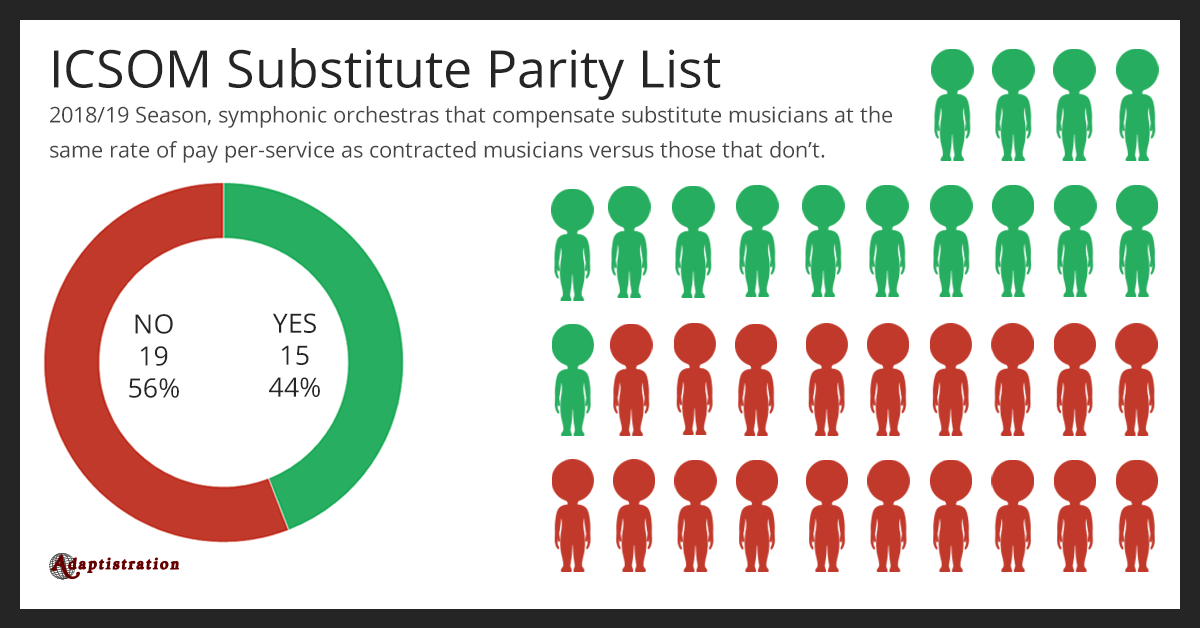In 2014, we took a deep dive into which International Conference of Symphony and Opera Musicians (ICSOM) symphonic orchestras paid substitute musicians the same rate as core musicians and in the wake of a recent conversation with ICSOM chairperson Meredith Snow and ICSOM President Paul Austin, it’s time to update that list.
My thanks to Paul Austin for spearheading this effort and providing ICSOM’s list of changes. As with most comparative lists, methodology is crucial and since there is no universally accepted method by which professional orchestras calculate per service rates (one service = a rehearsal or concert), it’s important to arrive at a clear understanding of what constitutes the parity threshold.
To that end, after examining ICSOM’s list it became clear in my exchanges with Austin that our respective thresholds did not entirely align.
How Parity, Or Equal Pay For Equal Work, Is Calculated
The threshold used here at Adaptistration is very straightforward: the per-service substitute musician rate must fall within one percentage point of the core musician per-service rate.
It’s a very empathy driven approach; meaning, if you were the substitute musician, would you consider anything less as equal pay for equal work. Having spoken to more substitute musicians about this issue than I can remember, the answer is always an emphatic “no.”
Divergent to this is ICSOM’s approach, where intent and service type (rehearsal or performance) influences where member orchestras end up on this chart as much as actual dollar-to-dollar calculations.
When compared to the 2014 list, ICSOM contends the following orchestras should move from the non-parity to parity list:
- Minnesota Orchestra
- Alabama Symphony
- San Antonio Symphony
- Pittsburgh Symphony
After checking each of those orchestra’s respective collective bargaining agreements, I determined only Pittsburgh crossed the threshold when Adaptistration’s methodology was applied.
In order to clarify those differences, I reached out to Austin with the following observations and questions:
- Minnesota’s parity doesn’t begin until the 2019/20 season. While I can see where that will apply once the season rolls around, to the substitutes being paid now, it wouldn’t be fair to them if the orchestra was listed in the parity group until then.
- In Alabama’s case, while performances pay substitutes 100% of member pay ($139.43 per service in the 2018-19 season), but rehearsals only pay $110, or 78.9 percent, of member pay. While it’s good to see parity in at least one type of service, they need to provide parity for all services in order to move out of the non-parity column.
- In San Antonio’s case, thanks to some extended instability marked with a patch-work of stopgap one-year agreements, the actual rates aren’t clearly defined. How did ICSOM go about determining parity?
Austin took the time to provide thoughtful replies for each item:
“[For Minnesota] ICSOM believes that because there is a binding contractual obligation to bring the subs to parity next year, they should be included in the parity group.”
“We think it is important to note that the Alabama musicians got the performance rate to 100% in the 2017-20 contract for the first time, and improved the rehearsal rate substantially. In general, we would very much like to emphasize the progress that has been made in places like Alabama, Milwaukee, and Indianapolis.”
“The most recent contract [in San Antonio] increases sub rehearsal rate to $125 and performance rate to $152 for 2017/2018. Weekly salary of $1120 divided by 8 is $140, so we’re estimating parity or close to it, depending on the mix.”
In Minnesota’s case, the parity exists in this current season and for those subs, any impending changes don’t alter current discrepancies. At the beginning of next season when the new rate goes into effect, listing that group as providing sub parity would be accurate. But for now, failing to acknowledge unequal pay risks doing a disservice to substitute musicians, none of which were able to vote on the agreement that approved the five-year disparity.
In Alabama’s case, while I agree that progress is good and highlighting it is entirely worthwhile, it still doesn’t resolve the actual disparity.
In San Antonio, I am still unable to verify the actual contract language so for now, the group will go into parity limbo, so to speak, until it can be verified.
Originally Left Out
The 2014 chart neglected to include two ICSOM orchestras: Grand Rapids Symphony and Florida Orchestra. Both of those orchestras do meet Adaptistration’s threshold for parity and will be included in this update.
ICSOM Substitute Parity List For The 2018-19 Season
Orchestras that compensate substitute musicians at the same rate of pay per-service as contracted musicians:
- Chicago Symphony
- Dallas Symphony
- Detroit Symphony
- Florida Orchestra
- Fort Worth Symphony
- Grand Rapids Symphony
- Nashville Symphony
- New Jersey Symphony
- New York Philharmonic
- Pittsburgh Symphony
- Rochester Philharmonic
- Louis Symphony
- San Francisco Symphony
- Utah Symphony & Opera
- Virginia Symphony
Orchestras that do not compensate substitute musicians at the same rate of pay per-service as contracted musicians:
- Alabama Symphony
- Atlanta Symphony
- Baltimore Symphony
- Boston Symphony
- Cincinnati Symphony
- Cleveland Orchestra
- Colorado Symphony
- Columbus Symphony
- Houston Symphony
- Indianapolis Symphony
- Kansas City Symphony
- Los Angeles Philharmonic
- Milwaukee Symphony
- Minnesota Orchestra
- National Symphony
- North Carolina
- Oregon Symphony
- Philadelphia Orchestra
- Phoenix Symphony
TBD: San Antonio Symphony

Many thanks to ICSOM President Paul Austin for engaging in a such a transparent and engaging fashion, this entire exercise is better for it. We’ll see about updating the list once the balance changes.


